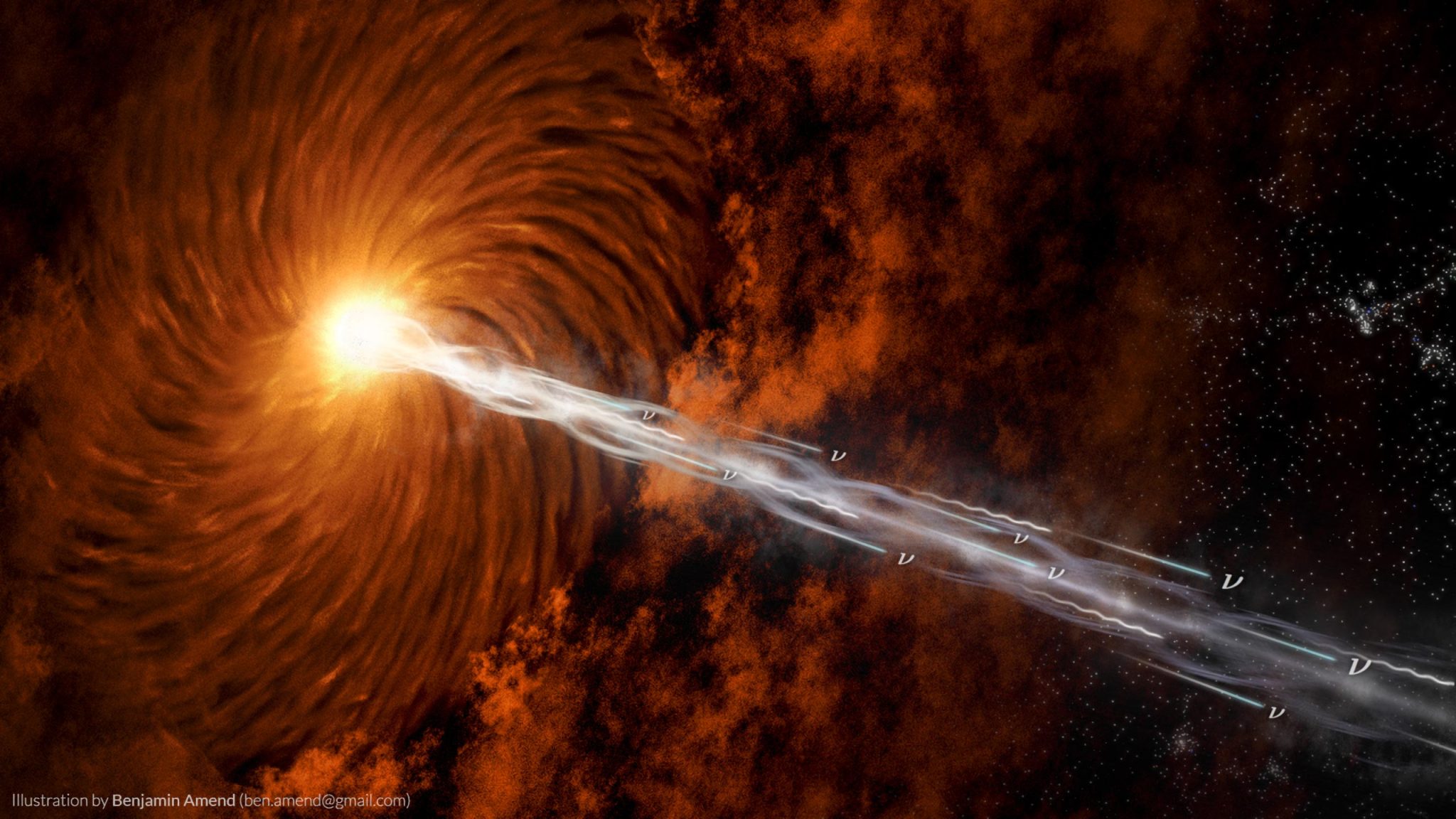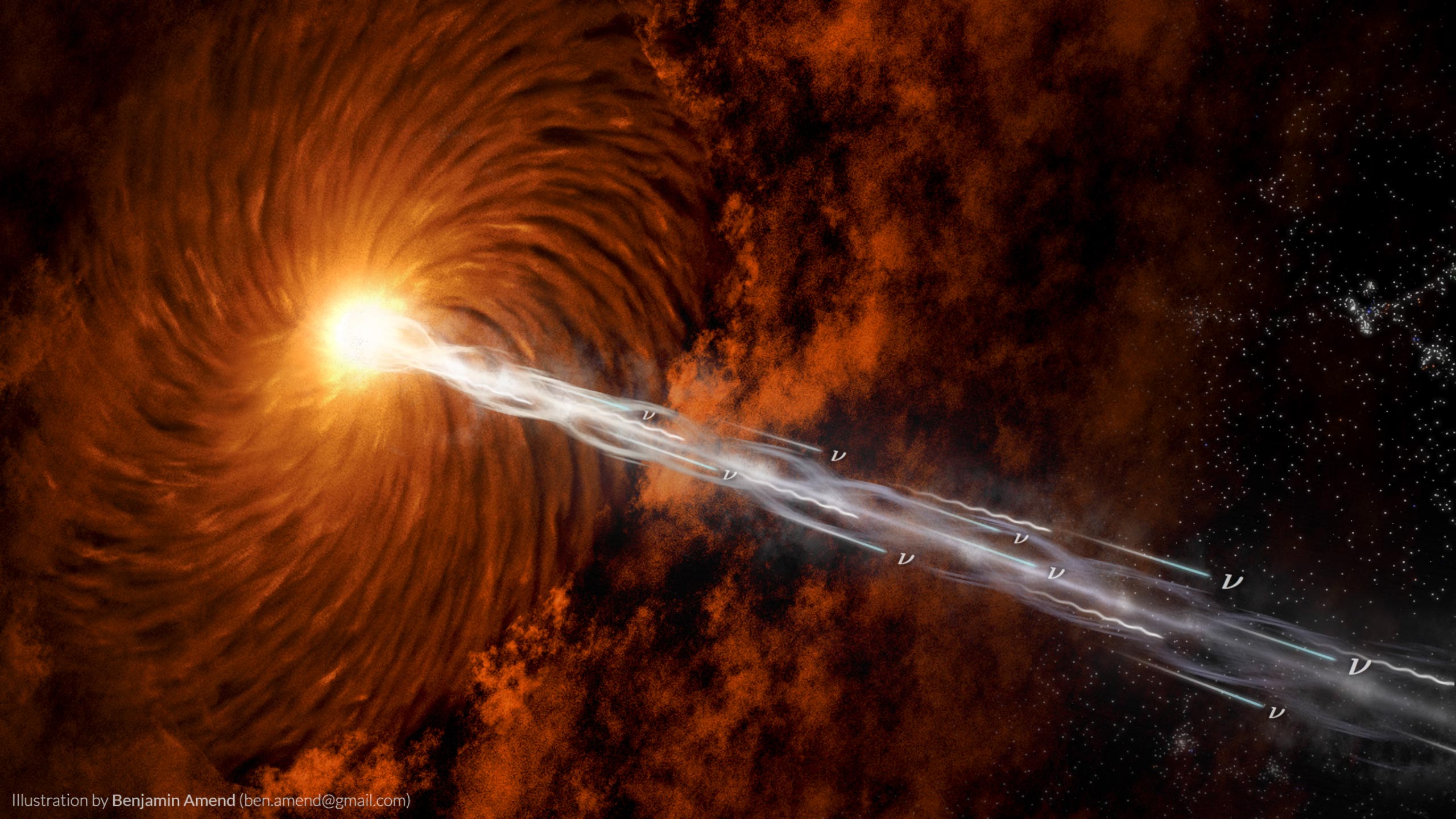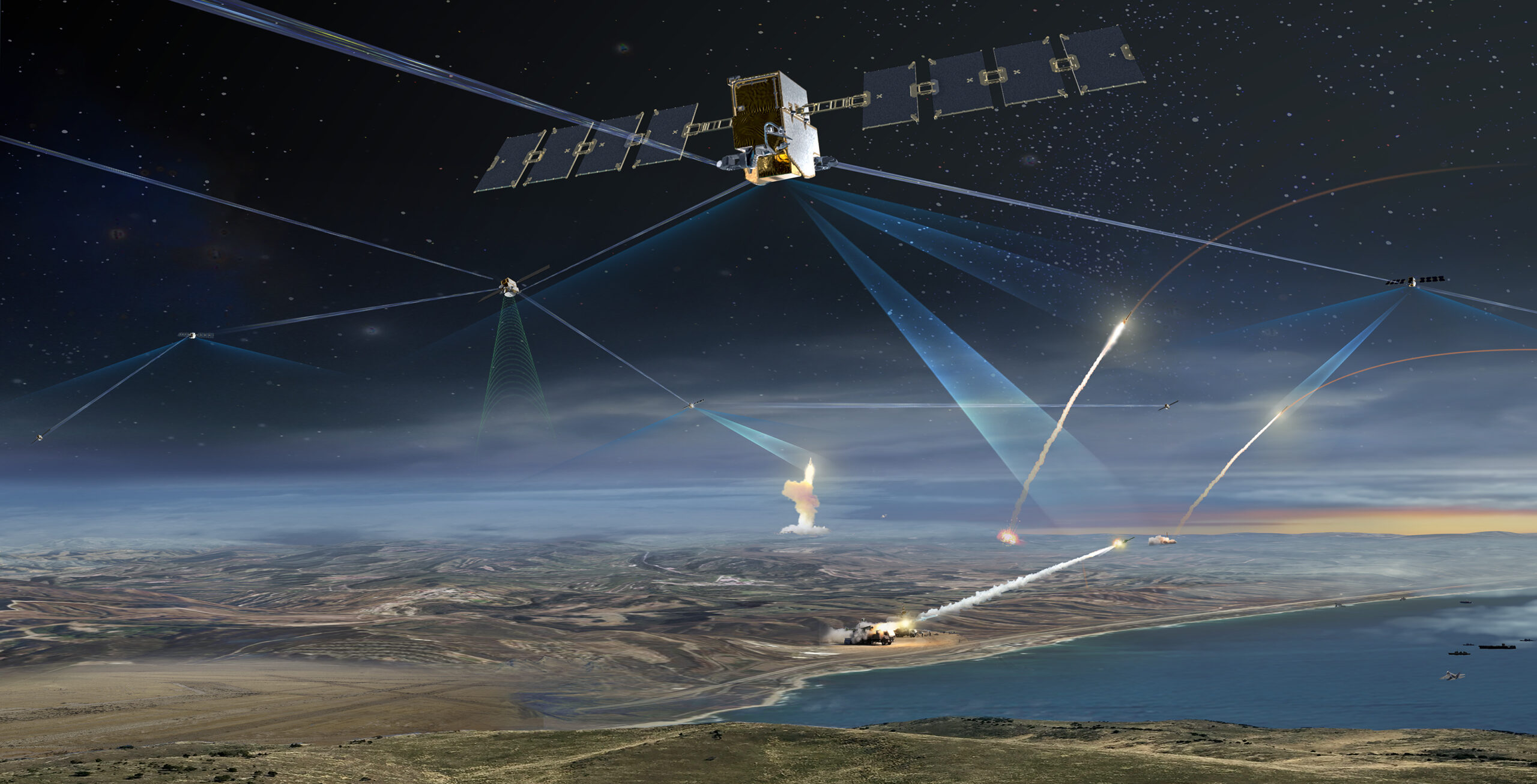
Aufbruch ins All: Die Entdeckung extragalaktischer Neutrinofabriken. Bildnachweis: © Benjamin Amend
Forscher enthüllen erstmals die Herkunft von Neutrinos, Elementarteilchen, die aus den Tiefen des Universums unseren Planeten erreichen.
Hochenergetisch und schwer zu entdecken, legen Neutrinos Milliarden von Lichtjahren zurück, bevor sie die Erde erreichen. Obwohl bekannt ist, dass diese Elementarteilchen aus den Tiefen unseres Universums stammen, ist ihre genaue Herkunft immer noch ein Rätsel. Ein internationales Forscherteam unter der Leitung der Universität Würzburg und der Universität Genf (UNIGE) bringt Licht in einen Aspekt dieses Rätsels: Neutrinos sollen in Blazaren geboren werden, galaktischen Kernen, die von supermassiven Schwarzen Löchern gespeist werden. Diese Ergebnisse wurden am 14. Juli in der Zeitschrift veröffentlicht Astrophysikalische Zeitschriftenbriefe.
Die Atmosphäre unseres Planeten wird ständig von kosmischer Strahlung bombardiert. Es besteht aus elektrisch geladenen Teilchen mit extrem hohen Energien – bis zu 1020 Elektronenvolt. Zum Vergleich: Das ist millionenfach mehr als die Energie, die im leistungsstärksten Teilchenbeschleuniger der Welt erreicht wird.[{“ attribute=““>CERN’s Large Hadron Collider near Geneva. The incredibly energetic particles come from deep outer space and have traveled billions of light years. Where do they originate, what shoots them through the Universe with such tremendous force? These questions have remained among the greatest challenges of astrophysics for over a century.
Cosmic rays’ birthplaces produce neutrinos. These neutral particles are very difficult to detect. They have almost no mass and barely interact with matter. They race through the Universe and can travel right through galaxies, planets, and the human body almost without a trace. “Astrophysical neutrinos are produced exclusively in processes involving cosmic ray acceleration,” explains astrophysics Professor Sara Buson from Julius-Maximilians-Universität (JMU) Würzburg in Bavaria, Germany. This is precisely what makes these neutrinos unique messengers paving the way to pinpoint cosmic ray sources.
A step forward in a controversial debate
Despite the vast amount of data that astrophysicists have collected, the association of high-energy neutrinos with the astrophysical sources that originate them has remained an unsolved problem for years. Sara Buson has always considered it a major challenge. It was in 2017 that the researcher and collaborators first brought a blazar (TXS 0506+056) into the discussion as a potential neutrino source in the journal Science. Blazars are active galactic nuclei powered by supermassive black holes that emit much more radiation than their entire galaxy. A scientific debate was sparked by the publication about whether there truly is a connection between blazars and high-energy neutrinos.
Following this first encouraging step, in June 2021 Prof. Buson’s group began an ambitious multi-messenger research project with the support of the European Research Council. This involves analyzing various signals (“messengers,” e.g. neutrinos) from the Universe. The main goal is to shed light on the origin of astrophysical neutrinos and possibly establish blazars as the first source of extragalactic high-energy neutrinos with high certainty.
The project is now showing its first success: In the journal Astrophysical Journal Letters, Sara Buson, along with her group, the former postdoctoral researcher Raniere de Menezes (JMU) and Andrea Tramacere from the University of Geneva, reports that blazars can be confidently associated with astrophysical neutrinos at an unprecedented degree of certainty.
Revealing the role of blazars
Andrea Tramacere is one of the experts in numerical modeling of acceleration processes and radiation mechanisms acting in relativistic jets — outflows of accelerated matter, approaching the speed of light — in particular blazar jets. “The accretion process and the rotation of the black hole lead to the formation of relativistic jets, where particles are accelerated and emit radiation up to energies of a thousand billion of that of visible light! The discovery of the connection between these objects and the cosmic rays may be the ‘Rosetta stone’ of high-energy astrophysics!”
To arrive at these results, the research team utilized neutrino data from the IceCube Neutrino Observatory in Antarctica — the most sensitive neutrino detector currently in operation — and BZCat, one of the most accurate catalogues of blazars. “With this data, we had to prove that the blazars whose directional positions coincided with those of the neutrinos were not there by chance.” To do this, the UNIGE researcher developed software capable of estimating how much the distributions of these objects in the sky look the same. “After rolling the dice several times, we discovered that the random association can only exceed that of the real data once in a million trials! This is strong evidence that our associations are correct.”
Despite this success, the research team believes that this first sample of objects is only the ‘tip of the iceberg’. This work has enabled them to gather “new observational evidence”, which is the most important ingredient for building more realistic models of astrophysical accelerators. “What we need to do now is to understand what the main difference is between objects that emit neutrinos and those that do not. This will help us to understand the extent to which the environment and the accelerator ‘talk’ to each other. We will then be able to rule out some models, improve the predictive power of others and, finally, add more pieces to the eternal puzzle of cosmic ray acceleration!”
Reference: “Beginning a Journey Across the Universe: The Discovery of Extragalactic Neutrino Factories” by Sara Buson, Andrea Tramacere, Leonard Pfeiffer, Lenz Oswald, Raniere de Menezes, Alessandra Azzollini and Marco Ajello, 14 July 2022, Astrophysical Journal Letters.
DOI: 10.3847/2041-8213/ac7d5b

Schöpfer. Hipster-freundlicher Unternehmer. Student. Freundlicher Analyst. Professioneller Schriftsteller. Zombie-Guru. Amateur-Web-Nerd.



















+ There are no comments
Add yours